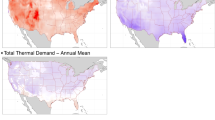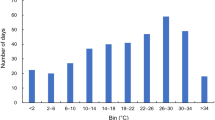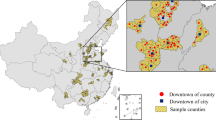Abstract
This paper presents an empirical study of the relationship between residential energy demand and temperature. Unlike previous studies in this field, the data sample has a global coverage and special emphasis is given to the heterogeneous response of different regions and to the contrasting effects on energy demand for cooling and heating purposes. To account for this we distinguish between different regions, seasons, and energy sources. Short- and long-run temperature demand elasticities are estimated. These features make the model results especially valuable in the analysis of climate change impacts as they provide an empirical basis for the study of the impact of climate change on energy demand. To illustrate the potential of the results as a basis for the study of climate change impacts, the estimates are used in a simple exercise that projects changes in energy demand due to temperatures increase in 2085.



Similar content being viewed by others
Notes
We exclude the analysis of coal because of data limitations regarding coal prices.
The choice of the indicator used for temperature change is discussed in the following section.
Note that the distinction between colder and warmer climates can only partially account for the geographic variability between and within regions. In fact, variables other than average temperatures may be relevant, such as the presence of mountains, coastal areas, lakes, precipitations or monsoons.
Degree days are defined in relation to the difference between the observed temperature and a threshold value, which can vary across regions. When the average daily temperature is above a certain threshold, the day is classified as a cooling degree day. It is a heating degree day when the average daily temperature is below the threshold and therefore, when it is cold. The threshold is calculated based on the heating and cooling needs.
The present work deals with a panel of countries that belong to different hemispheres. In this context simply using seasonal averages for all countries would have created a bias in the different behavior between northern- and southern-hemisphere countries. Consequently, seasonal temperatures were calculated as the average temperature in the months related to a certain season. For example, winter temperature in France is the average between the temperatures of December, January and February, whereas in Australia it is the average between the temperatures of June, July, and August.
Recent econometric literature on panel data have compared the validity of homogeneous versus heterogeneous estimators, to obtain energy demand elasticities with respect to price and income. Whereas some authors favor the pool estimator despite the rejection of the poolability assumption (Baltagi and Griffin 1997), Pesaran and Smith (1995) favor an estimator based on the individual time series.
Not all countries are included as the tree only displays countries with a certain degree of difference in annual temperatures. Nevertheless, the cluster analysis is applied to all countries in the sample used for the estimation and they are all assigned to a certain group.
To this end, we considered baseline consumption levels at 2000. Increases in energy consumption have been obtained on the basis of available population (source:GGI Scenario Database, http://www.iiasa.ac.at/Research/Models/index.html, referring to IPCC SRES scenario B2) and income per capita growth scenarios (source: own elaboration from World Bank data). Changes in energy demand due to higher income levels were obtained using income demand elasticities estimated in this study.
References
Asadoorian OM, Eckaus R, Schlosser CA (2006) Modeling climate feedbacks to energy demand: the case of China, MIT joint program on the science and policy of global change. Report no. 135
Balestra P, Nerlove M (1966) Pooling cross-section and time-series data in the estimation of a dynamic model: the demand for natural gas. Econometrica 31:585–612
Baltagi BH, Griffin JM (1997) Pooled estimators versus their heterogeneous counterparts in the context of dynamic demand for gasoline. J Econom 77:300–327
Beenstock M, Goldin E, Nabot D (1999) The demand for electricity in Israel. Energy Econ 21:168–183
Bigano A, Bosello F, Marano G (2006) Energy demand and temperature: a dynamic panel analysis. Fondazione ENI Enrico Mattei working paper no. 112.06
Durlaf SN, Johnson PA (1995) Multiple regimes and cross-country growth behavior. J Appl Econ 10(4):365–384
Engested T, Bentzen J (1993) Short- and long-run elasticities for energy demand a co-integration approach. Energy Econ 15(1):9–16
Everitt B (1974) Cluster analysis. Heinemann Educ. Books, London
Hartigan JA (1975) Clustering algorithms. Wiley, New York
Hadri K (2000) Testing for stationarity in heterogeneous panel data. Econom J 3:148–161
Hanley A, Peirson J (1996) Energy pricing and temperature interaction: British experimental evidence. Aberystwyth Economic Research Paper, no. 96-16, University of Wales Aberystwyth
Hanley A, Peirson J (1997) Non-linearities in electricity demand and temperature: parametric vs. non-parametric methods. Oxf Bull Econ Stat 59:149–162
Hanley A, Peirson J (1998) Residential energy demand and the interaction of price temperature: British experimental evidence. Energy Econ 20:157–171
IEA (2010) International energy balances 2010. IEA, Paris
Im KS, Pesaran MH, Shin Y (2003) Testing for unit roots in heterogeneous panels. J Econom 115:53–74
Kaufman L, Rousseeuw PJ (2005) Finding group in data: an intro to cluster analysis. In: Wiley series in probability and statistics
Kouris G (1983) Energy consumption and economic activity in industrialised economies: a note. Energy Econ 5(3):207–212
Lehmijoki U, Paakkonen J (2006) Demographic clubs; convergence within, divergence between. Discussion paper no. 136, Helsinki Center of Economic Research
Levin A, Lin C-F (1993) Unit root tests in panel data: new results. Discussion paper 93-56, University of California, San Diego
Liu G (2004) Estimating energy demand elasticities for OECD countries—a dynamic panel data approach. Discussion papers no. 373, Statistics Norway, Research Department
Maddala GS, Wu S (1999) A comparative study of unit root tests and a new simple test. Oxf Bull Econ Stat 61:631–652
Madlener R, Alt R (1996) Residential energy demand analysis: an empirical application of the closure test principle. Empir Econ 21:203–220
Mansur ET, Mendelsohn R, Morrison W (2008) A climate change adaptation: a study of fuel choice and consumption in the US energy sector. J Environ Econ Manage 55:175–193
Masish AMM, Masish R (1996) Energy consumption, real income and temporal causality: results from a multy-country study based on cointegration and error-correction modeling techniques. Energy Econ 18:165–183
Mitchell T, Hulme M, New M (2003) A comprehensive set of climate scenarios for Europe and the globe. Tyndall Centre working paper 55
Moral-Carcedo J, Vicens-Otero J (2005) Modeling the non-linear response of Spanish electricity demand to temperature variations. Energy Econ 27:477–494
Nordhaus WD (1977) The demand for energy: an international perspective. In: Nordhaus WD (ed) International studies of the demand for energy. North Holland, Amsterdam
OECD (Organisation for Economic Co-operation and Development) (2008) OECD environmental outlook to 2030. OECD, Paris
Parti P, Parti C (1980) The total and appliance-specific conditional demand for electricity in the household sector. Bell J Econ 11:309–321
Pesaran MH, Smith R (1995) Estimating long-run relationships from dynamic heterogenous panels. J Econom 68:79–113
Pindyck RS (2006) Uncertainty in environmental economics. NBER working paper 12752
Prosser RD (1985) Demand elasticities in OECD: dynamical aspects. Energy Econ 7:9–12
Sadorsky P (2009) Renewable energy consumption, CO2 emissions and oil prices in the G7 countries. Energy Econ 31:456–462
Stern DI (2000) A multivariate cointegration analysis of the role of energy in the US macroeconomy. Energy Econ 22:267–289
Vaage K (2000) Heating technology and energy use: a discrete/continuous choice approach to Norwegian household energy demand. Energy Econ 22:649–666
Vahid F (2000) Clustering regression functions in a panel. Econometric Society world congress 2000 contributed papers 0251
Westerlund J (2007) Testing for error correction in panel data. Oxford Bull Econ Stat 69(6):1468–0084
Zarnikau J (2003) Functional forms in energy demand modeling. Energy Econ 26(6):603–613
Acknowledgements
The authors would like to thank Francesco Bosello, Claudio Agostinelli and Andrea Bigano for their guidance, and Carlo Carraro and Ian Sue Wing for useful comments. Andrea Bigano, Francesco Bosello and Giuseppe Marano are also gratefully acknowledged for providing the initial dataset used for the analysis.
Author information
Authors and Affiliations
Corresponding author
Appendices
Appendix A: Data statistics summary
Appendix B: Additional regressions
Rights and permissions
About this article
Cite this article
De Cian, E., Lanzi, E. & Roson, R. Seasonal temperature variations and energy demand. Climatic Change 116, 805–825 (2013). https://doi.org/10.1007/s10584-012-0514-5
Received:
Accepted:
Published:
Issue Date:
DOI: https://doi.org/10.1007/s10584-012-0514-5




